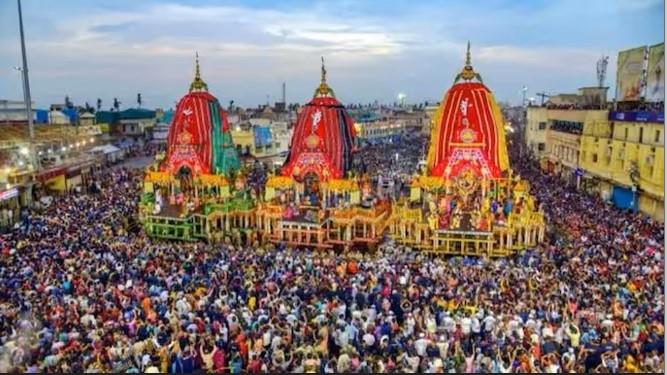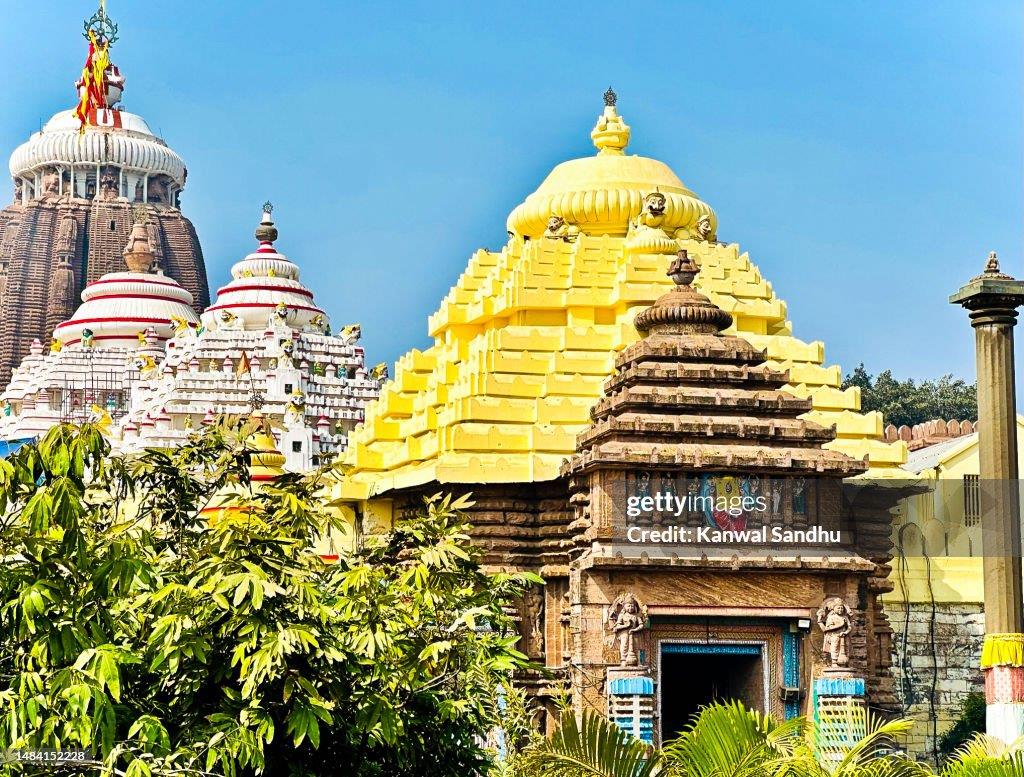
Controversy Over Puri Jagannath Temple's Links With Buddhism
Colombo, June 4: The 12 th. Century Jagannath temple in Puri in the eastern Indian State of Odisha (formerly Orissa) is one of the most revered and popular Hindu temples. Its annual Car/Cart/Chariot festival, called Ratha Jatra, held in June-July, is world famous.
Three gaily decorated and gigantic Carts, carrying the idols of Jagannath, Balabhadra and Subhadra, cruise through the streets of Puri thronged by lakhs of devotees during Ratha Jatra. One of the popular myths about the Ratha Jatra is that in earlier days, devotees would throw themselves on the path of the giant carts only to be crushed under their gigantic wheels and taken straight to heaven.
Overawed by these sights, the British, who took over Odisha in 1803, coined the term“Juggernaut” to denote a massive and brute force that would brook no opposition.
However, in the 19 th British administrators themselves admitted that these stories were fictitious. Such stories spread by Europeans were meant to portray Hindu practices as horrific forms of“paganism” thereby encouraging Christian missionaries to begin work among Indians.
Most recently, during the on-going Indian parliamentary election campaign, the Jagannath temple was again drawn into a nation-wide controversy. The Bharatiya Janata Party (BJP) leader and Prime Minister Narendra Modi charged that the keys of the temple's treasury (the Ratna Bhandar) were stolen and taken away to Tamil Nadu, the home State of K, the chief aide to the Odisha Chief Minister, Naveen Patnaik. Modi was angry that Patnaik and Pandian had refused to hitch their Biju Janata Dal (BJD) party to his National Democratic Alliance (NDA).
The candidate of the BJP in the Puri parliamentary constituency Sambit Patra muddied the issue further by saying that Lord Jagannath himself was a devotee of Modi's! When this remark became an issue, Patra claimed that it was a“slip of the tongue” and also went on a fast to atone for the sacrilege.
Meanwhile, Modi's insinuation that a Tamil, K, had stolen the keys to the Ratna Bhandar and hidden it in Tamil Nadu, inflamed the Tamils in Tamil Nadu who slammed him for casting aspersions on Tamils as a whole.
Buddhist Elements
The sea-side Jagannath temple in Puri houses three main idols, those of Jagannath himself, his brother Balabhadra and his sister Subhadra. Most Hindus believe that Jagannath is an incarnation of Vishnu. But many scholars, both Indian and Western, say that the temple was a Buddhist shrine which became Hindu over time. They see indications of its Buddhist links in the temple's ideology and practices.
The Buddhist origin of the deity Jagannath was first propounded by Maj Gen. Alexander Cunningham (1814-1893), the first Director-General of the Archaeological Survey of India. Later scholars such as Sir William Wilson Hunter (author of the Imperial Gazetteer of India),
W.J. Wilkins (19 th Hindu mythologist), Ceylonese art historian Ananda Coomaraswamy, R.L. Mitra, Dr. Hare Krushna Mahatab and
Mayadhar Mansinha used both literary and archaeological sources to approve of Cunningham's theory.
It is pointed out that in Tibetan Buddhist literature, the Buddha is named Natha, Jagannatha and Lokanatha. Scholars believe that the trio in the Jagannath temple (Jagannath, Balabhadra and Subhadra) represent the 'Tri-Ratna' (Triple of Gem) of Buddhism, namely, the Buddha, the Dharma and the Sangha.
On the basis of a legend mentioned in the Dathavamsa written by the Sinhalese Buddhist monk Dharmakirti Thera, scholars say that a tooth of the Buddha is kept in the Jagannath idol. But what is inside the idol is still a mysterious substance. It is thickly padded in silk. The Hindus believe that the secret substance is a representation of“Brahma”, the supreme God in the Hindu pantheon.
In his work Bhilsa Topes, archaeologist Alexander Cunningham argued that if the hidden substance is indeed a tooth of the Buddha,
Jagannath cannot be a Brahmanical (Hindu) God, because worship of
body parts is not allowed in Hinduism. He argued that since the practice is eminently Buddhist, Jagannath must have been a Buddhist deity.
Given the fact that Buddhism was the first religion in India to discard caste distinctions, no caste distinctions are observed in the Jagannath temple when the Mahaprasad (sanctified food) is distributed among the devotees.

Lord Jagannath Ratha Jatra
The cart festival of Lord Jagannath is thought to have been influenced by Mahayana Buddhism. Its origin is said to be the Cart Festival at Khotan, an ancient Buddhist Saka kingdom located in a branch of the ancient Silk Road that is in modern-day Xinjiang in China.
Jayadeva, an Odia poet of the 12th century, who wrote the celebrated work Gita Govinda, described the Buddha as the ninth incarnation of Vishnu. Jagannath is also deemed to be an incarnation of Vishnu. The Buddha also appears as one of the main twenty-two avatars of Vishnu in the Bhagavatam one of the Hindu Puranas. The Bhagavata Purana incorporates Gautama Buddha in Hindu theology as the 10th incarnation of Lord Vishnu. And the Jagannath temple in Puri is dedicated to Vishnu.
It is pointed out that there is an image of the Buddha in the Ellora caves in Maharashtra which is named Jagannath.
From the seventh century AD onwards many popular religions were incorporated in Mahayana Buddhism. King Indrabhuti, the earliest King of Odisha, is said to have united Buddhism with the cult of Jagannath.
Contrary View
However, despite the above arguments in favour of the Buddhist origin of Jagannath, many present-day scholars do not accept them. Abimanyu Dash writing in the June 2014 issue of Odisha Review argues that since Buddhism became the predominant religion of Odisha after Emperor Asoka became a Buddhist, it impacted the life, religion and literature of Odisha. As a result of this, scholars attempted to show similarities between the Jagannath cult and Buddhism.
The following arguments are made to debunk Jagannath temple's links with Buddhism: The identification of the three main idols in the Jagannath temple with the Buddhist Trinity (Tri-Ratna) is not acceptable because the actual number of icons in the temple are not three, but four, namely Jagannath, Balabhadra, Subhadra and Sudarsana.
In the Hindu or Brahmanical tradition, there are several“trios”, such as Brahma, Vishnu and Mahesvara; Rama, Laksmana, and Sita; Krishna, Balarama and Subhadra. So, there cannot be any valid reason to consider Jagannath, Balabhadra and Subhadra as the Buddhist trio of Buddha, Dharma (Dhamma) and Sangha.
The term Jagannath is generally used as an adjective to suggest the higher status of any God or King. As such, the term Jagannath in Pali literature cannot be associated exclusively with Jagannath of Puri.
There is no similarity between the Dhamma symbol at Sanchi and Subhadra in the Jagannath temple at Puri. The Dhamma symbol at Sanchi has hands whereas Subhadra has no hands.
At the Ellora caves one finds the coexistence of sculptures relating to Buddhism, Hinduism and Jainism.
This shows an“assimilation of cults” within a single place of worship and not the“unity” of Buddha and Jagannath.
Cart festivals had been mentioned in the literature of the Vedic and Upanishadic periods. In Atharva Veda, there are references to Gods coming down in chariots.
Buddhism is casteless. But the practice of distributing the Mahaprasada (sanctified food) regardless of caste distinctions is not peculiar to Buddhism. The Puranas and the Tantric texts say that the
Mahaprasada is to be distributed regardless of caste or sex.
The Buddhist tradition also prescribes that no symbol of the Sakya Muni (the Buddha) is to be worshipped secretly. But the mysterious substance in the Jagannath icon is worshipped secretly.
END

Legal Disclaimer:
MENAFN provides the
information “as is” without warranty of any kind. We do not accept
any responsibility or liability for the accuracy, content, images,
videos, licenses, completeness, legality, or reliability of the information
contained in this article. If you have any complaints or copyright
issues related to this article, kindly contact the provider above.


















Comments
No comment